This page provides links to the material we used during our staff training day in June 2019. The theme of the day, was Through the Eyes of the Child.
Session 1 – Introduction
We started the day by watching a video by introducing ourselves as one of our key children, and spoke in the first person, telling the group how ‘we saw the world of the gan’ from our perspective. We spent time crawling around the building looking at play and learning spaces from children’s perspectives, and considered what we could learn from this.
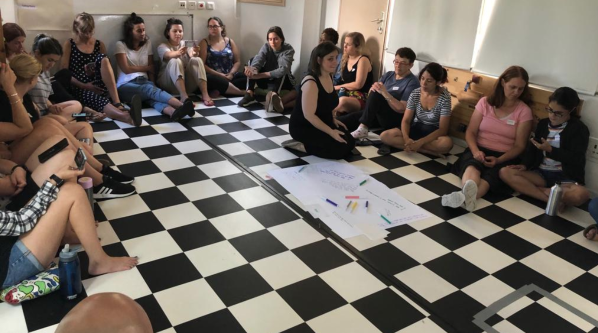
We watched a video about a programme called ‘Roots of Empathy’ in Canada, where babies come into elementary school classrooms to help children ‘learn’ from them.
We considered how (and what!) we could learn from our key children.
Session 2 – Impulse Control
During session 2, we considered how our key children manage impulse control and linked the idea of Impulse control to biting, and identified this and the most common cause (reason) for biting. We spent the session, taking part in physically active games that can be used in the gan to support children develop their sense of Impulse control.
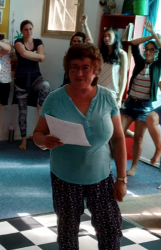
Red Light/Green Light
Creep towards leader but freeze when he says red light. But if the person at the front spots them moving when he/she says red light, then they become yellow lights and just walk on the spot for one turn , then they join in again.
Each time there is a new leader they have to walk in a different way e.g. backwards (towards the leader)! Or on tiptoes or in a zig zag, or crawling
Skills: Freeze teaches children to wait. Teaching children to stop and THINK before doing an action. Not rushing forward or they might get caught out when leader says red light, teaches them to be more cautious-less impulsive. Body control when they freeze. To stop and start. Spatial awareness. Gross motor skills from different ways of walking e.g backwards, in a zig zag
Talking points: Difference between red lights and green lights. How hard is it to freeze? How hard is it to walk in different ways? Was the game scary because you never know when the leader is going to turn around? What did you feel like if the leader saw you moving and you had to wait? How did it feel if you succeeded in reaching the leader? When do we have to freeze – or at least stop before we move (When we think we might be about to do something not right/bad/naughty. And at a road!)
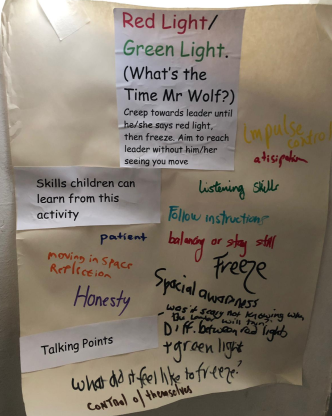
Wacky Relay
Two people carry an object from A-B only using a body part. Larger objects are easier so with small children use a ball or a furry toy, but to make it hard for adults we can use a pen/pencil. For example: Body parts could be only using their elbows, or knees, or forehead etc.
Skills: Body parts , Team work. Sharing. Social skills. Not to impulsively rush off if partner isn’t at same pace as you. Having to control your emotions so you and partner can work together. To be aware of other child. Balancing with an object. Overcoming shyness.
Talking points: What was difficult about the game? Did you work well together with your partner? Did you help each other? Or not? Did you like having to work with someone else?
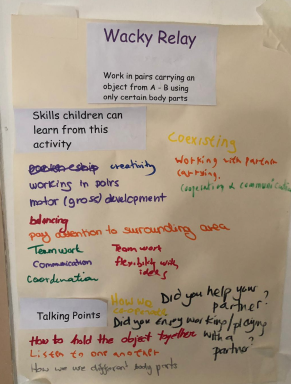
Simon Says
To make it harder for adults they will have to do more complex actions. If you don’t want anyone out, you just put them in two groups and if they follow the instruction but you haven’t said the word Simon, they just have to move from one group to the other.
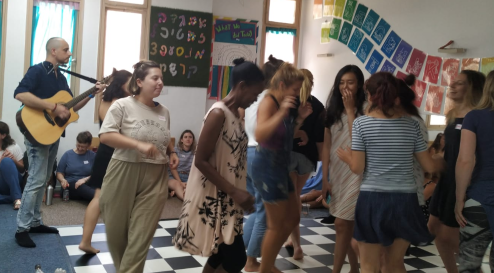
Skills: Not to impulsively move until you listen and hear the instruction. Body parts. To make independent decisions and not to copy person next to you.
Talking points: Why did you still move even though we didn’t say the word Simon says? Talk about all the body parts. Can each body part reach another? Can you see all the parts of your body? Was it hard to listen to instructions? What did it feel like if you were Out( or had to move to the other group?)
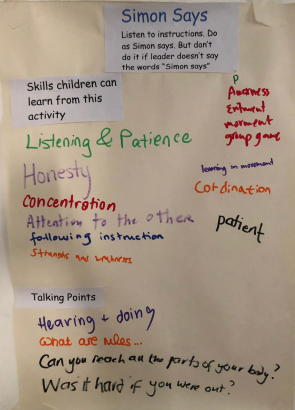
Yes and No.
Using different sounds. Can only say Yes and No. Have a conversation but use as many different timbres of sound (not accents) as you can while only using Yes and No. Practice angry sad, loud, soft, cajoling, pleading, whining, berating. Have a conversation just with yes and no.NO TOUCHING EACH OTHER -ONLY USE WORDS.
Skills: Using different sounds. Impulse control includes how we communicate. Using your voice instead of being physical. We have to learn the effect of different sounds. We want children to know how to use their indoor softer voices and not just shout. Skills learnt here are to control our voices and recognize the effect different sounds have on different people and for different occasions. Can help children use words.
Talking points: How hard is it just to say Yes and No? Could you manage to use lots of different sounds? What were they? When we say use you indoor voice do you know what we mean? What was it like when you’re partner was using a loud voice? A soft voice? An angry voice? A sad voice? Using words not just reacting physically. (Even though this game hardly uses any words but you mustn’t get physical). What words can we use when we feel……………..? (All the emotions)
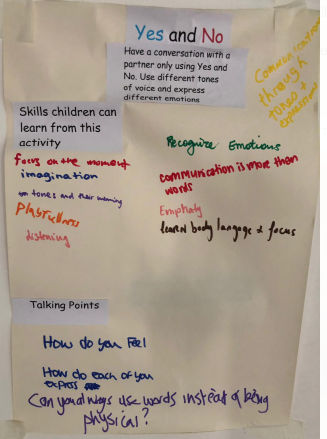
Cause and effect cards.
These are cards to trigger conversations with children about what happened first and what happened next. Have to show them the cards and ask them to put them in order (Just A or B or sometimes C). Keep asking them questions about the cards. Not just what order but why and what would happen if they were in a different order or the action happened and no one did anything after that?
Skills: Teach sequencing. If one thing happens it has an effect. If you can’t control yourself there are consequences. Your actions affect others.
Talking Points: Everything about cause and effect. Might not have direct conversations but message is in sharing the cards.
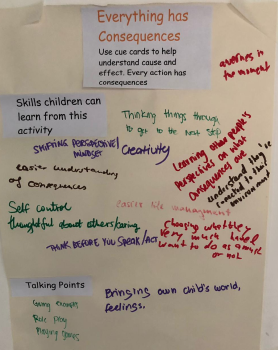
We looked at how basic sign language can support children’s communication, and how introducing signs can have a positive impact on impulse control
Skills: Help young babies communicate before they can speak. Prevents build up of frustration and temper tantrums. Teaches there are alternative ways of communicating. Power of communication at a very young age.
Talking points: You won’t be able to have talking points with babies BUT you can repeat these signs over and over to teach them and you can look up more like Don’t touch and Wait.
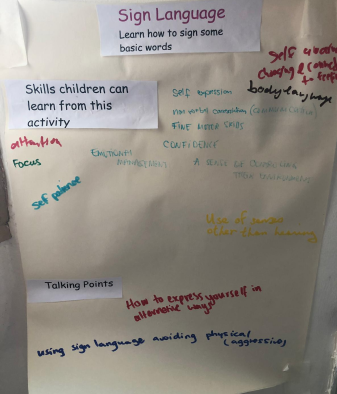
Any the end of the session, we identified any further ideas that we had which could support children with Impulse Control. We also considered how our identified key children would engage with these games, and which skills specifically would be useful to them.
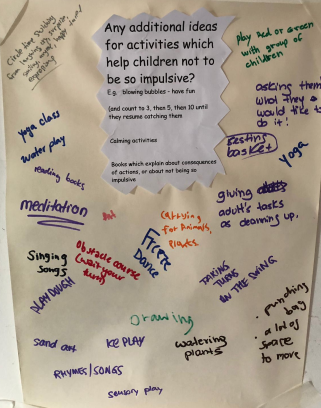
Summary notes on biting and Impulse control session:
Getting children (especially impulsive children) to stop doing something:
- Has to be more than eliminating that specific bad behaviour. Must always be an opportunity to teach
- So find a substitute to the bad behaviour: “ I don’t want you to throw our clothes around so here’s a ball which you can throw”
- Say your “No” in a positive. Instead of don’t throw the towel on the floor, say “When you’ve finished with your towel, hang it here please”
- Always encourage a child to use words to express feelings instead of being physical.
Pat Libbey The 3 C’s
- Commitment -make a rule and commit to it
- Communicate: Make sure child understands rule and consequences of breaking it
- Consistency: Follow through
If children are old enough, encourage child themselves to think of any solution so they problem solve e.g How could you get the toy from Ben without biting him? Try to get child to think about a solution and if that solution would work.
General rule for impulsive children: Stretch Wait time.
Use STAR – STOP THINK ACT RIGHT
Biting – Possible reasons:
- Jealous,
- impulsive,
- protective so uses it as self defence,
- lacking skills like limited vocab,
- seeking control,
- frustrated too little to play with,
- overwhelmed -too many other children and not getting attention,
- imitating,
- stressed (possibly from home not kindergarten),
- In the habit and has been allowed to get away with it
Some helpful steps to responding to biting behaviours:
- Step in ASAP and also watch for frustrations building up
- Centre attention on victim
- Help child to replace biting with words
- Help biting child to be kind -help the victim, play with showing sympathy to dolls/ animals/ other children
- Use games which involve being confident and using a strong voice for children using biting in self defence (because bully won’t give them what they want)
- Praise them when they have self control
- Cool them down with water play, popsicles, blowing bubbles, playing with blowing windmill sticks, play dough
- Reduce transition times when moving children around the building
- Play cause and effect type of activities
- Don’t just teach them to say I’m sorry as they might think they can say it and then it’s all OK.
Reading list related to this session:
Teeth are not for Biting. By Elizabeth Verdick and Marieka Heinlen; Best Behaviour Series https://www.amazon.com/Teeth-Biting-Board-Book-Behavior/dp/1575421283/ref=sr_1_1?crid=2O4QSASUNVQKI&
No more Biting for Billy Goat by Bernette Ford
https://www.amazon.com/More-Biting-Billy-Ducky-Piggy/dp/1907967311
Little Dinos don’t Bite by Michale Dahi
https://www.amazon.com/dp/1404875360/ref=pd_lpo_sbs_dp_ss_2?pf_rd_p=aeebc627-7ecf-4129-8c0c-1d437f2
No Biting by Karen Katz https://www.amazon.com/No-Biting-Lift-Flap-Book/dp/044842584X/ref=sr_1_1?crid=1EWT3ETRK71IK&keywords
Session 3: Becoming better supervisors (team leaders) and Effective Early Years Practice (practitioners)
For this session, we split into Team leaders and early years practitioners. Bebe Jacobs worked with the team leaders on supervision and and coaching skills and Sammy Fugler worked with the practitioners on looking at specific elements of our early years practice.
[slideshare id=152342168&doc=effectivepracticepresentation-190628063556]
Click Here for the Coaching and Supervision session for Team Leaders
Session 4: Using music everyday
We had an outside Workshop leader; Yoav Neeman – who delivered a workshop on using music through the gan day in a range of ways. He taught action songs, and helped us consider how to use rhythm and song throughout our daily routines.
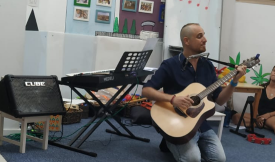
Session 5: Meetings with Parents
We considered the role of the key worker in meeting with parents and how team leaders could support staff undertaking meetings.
[slideshare id=152336017&doc=meetingswithparents-190628055529]
Then… we watched and analysed a comedy sketch about meeting with parents, and considered what we could learn from this.
Specially, we noticed that the teachers were struggling with how to ‘Open the Meeting’.
We reviewed a range of ways that meetings could be opened, and followed Bebe’s ‘top tips’ and practiced saying allowed some of her phrases.
Click here to download Meeting Openers top tips.
Use of language
We carefully considered the kind of language that should be used in parent meetings and sorted 60 cards, into things we would NOT say, things we would say ONLY after consultation with our Team Leader, and things that we WOULD say in regular conversations and meetings with parents.
Click here to download the phrases sheets – with the answers
Questions parents might ask, and how to respond
We split into 4 groups, and looked at parent scenarios and considered how to approach and respond. We used role play and forum theatre techniques to support staff in developing confidence in tacking these situations according to Rainbow Policy.
Click here to download the parent scenarios
Tips for finishing meetings
Click here to download the top tips for finishing off meetings, fillers and suggestions for phrases when responding to difficult questions.
Click here to view what the team leaders discussed in their breakout groups
Conclusion
We ended the day by considering what we could (or have) learnt from our own key children, and how this will impact upon or change our practice.
